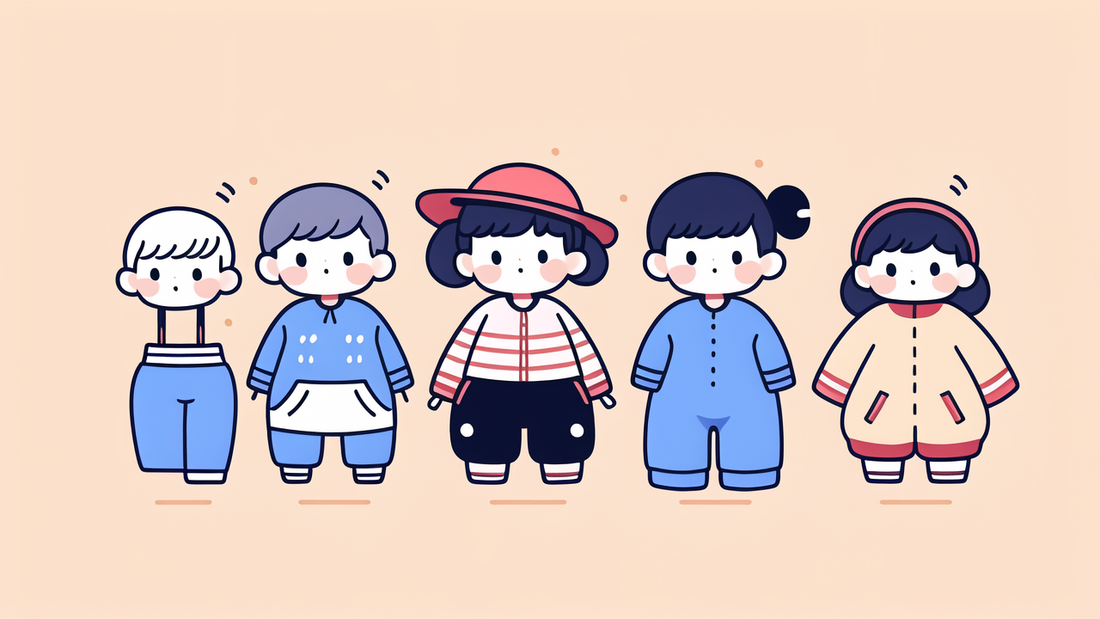
From Spring to Fall: Essential Baby Clothes Sets for Year-Round Comfort
Springtime Breezes: Best Baby Clothes for the Transition Season
Understanding Spring Weather: What Babies Wear
Spring weather can be unpredictable. It's often a mix of warm sunny days and cool, rainy ones. This makes dressing your baby a bit tricky. The key is to have versatile clothes that can adapt to changing temps.

For chilly mornings, start with a onesie as a base layer. Add a light sweater or cardigan on top. This can be easily removed if it gets warmer. Soft, breathable fabrics like cotton are best. They keep baby comfy and prevent overheating.
On warmer days, a short-sleeved bodysuit might be enough. Pair it with soft pants or leggings. Always have a light jacket on hand for sudden cool breezes. Don't forget a sun hat to protect your little one's delicate skin.
Remember, babies can't regulate their body temp as well as adults. It's better to dress them in layers. This way, you can add or remove clothing as needed. Keep an eye on your baby's comfort level throughout the day.
Key Pieces for a Spring-Ready Baby Clothes Set
A well-planned spring baby clothes set should include:
- Bodysuits: Both long and short-sleeved options
- Light sweaters or cardigans
- Soft pants or leggings
- Socks
- A light jacket or windbreaker
- Sun hat
- Gentle fabric shoes or booties
Choose clothes made from natural, breathable fabrics. Cotton is a great choice. It's soft, durable, and helps regulate body temperature. Look for clothes with easy-to-use snaps or zippers. These make diaper changes quick and fuss-free.
Opt for neutral colors that can mix and match easily. This lets you create more outfits with fewer pieces. Don't forget about comfort. Avoid clothes with scratchy tags or rough seams. Your baby's comfort should always come first.
Summer Bliss: Dressing Your Baby for the Heat
Selecting the Perfect Summer Baby Clothes Set
When summer arrives, keeping your baby cool becomes the top priority. The right clothes can make all the difference in your baby's comfort. Look for lightweight, breathable fabrics that allow air to circulate.

A summer baby clothes set should include:
- Short-sleeved bodysuits
- Light, airy rompers
- Soft, loose-fitting shorts
- Sun hats with wide brims
- Light cotton socks
- Sleeveless tops
Cotton is still a great choice for summer. It's breathable and absorbs sweat well. Linen is another good option. It's light and dries quickly. Avoid synthetic fabrics that can trap heat and cause irritation.
Choose light colors that reflect sunlight rather than absorb it. White, pale yellow, and light blue are good options. These colors help keep your baby cooler in the sun. Remember to always use sunscreen on exposed skin.
For bedtime, lightweight sleep sacks or thin cotton pajamas work well. They keep baby comfy without overheating. On extra hot nights, a diaper and light top might be enough.
Tips for Maintaining Your Baby's Clothing in Top Condition
Proper care of your baby's clothes helps them last longer. Here are some tips:
- Always read care labels before washing
- Use a gentle, baby-safe detergent
- Wash new clothes before your baby wears them
- Treat stains promptly to prevent setting
- Avoid using fabric softeners, which can irritate baby's skin
- Air-dry clothes when possible to prevent shrinkage
For tough stains, try soaking in warm water with a bit of baby-safe stain remover. Sunlight can also help naturally bleach out stains. Just be careful not to leave clothes in direct sun for too long.
Store clothes in a cool, dry place to prevent mold and mildew. Keep seasonal items in airtight containers. This protects them from dust and pests. Donate or pass on outgrown clothes in good condition to friends or charities.
Cozy Autumn Days: Preparing for the Cooler Season
Layering Strategies for Fall Baby Wear
As autumn approaches, it's time to think about keeping your baby warm. Layering is key for fall baby fashion. It allows you to adjust your baby's outfit as the temperature changes throughout the day.

Start with a base layer, like a onesie or long-sleeved bodysuit. Add a middle layer for warmth, such as a light sweater or fleece top. The outer layer should be a jacket or coat that can be easily removed.
Here's a basic fall layering strategy:
- Base layer: Thin, breathable fabric like cotton
- Middle layer: Insulating material like fleece or wool
- Outer layer: Water-resistant jacket or coat
Remember to check your baby's temperature often. Babies can't tell you if they're too hot or cold. Feel their chest or back. If it's warm and dry, they're probably comfortable.
Don't forget about legs and feet. Warm socks and soft booties are essential. For crawlers, consider pants with reinforced knees. They'll last longer and protect your baby's legs.
The Importance of Seasonal Changes in Baby Fashion
Adapting your baby's wardrobe to the seasons is about more than just fashion. It's crucial for your baby's comfort and health. Each season brings unique challenges in dressing your little one.
In spring and fall, the key is versatility. These transition seasons require clothes that can adapt to changing temperatures. Summer focuses on keeping baby cool and protected from the sun. Fall and winter are all about warmth and coziness.
Seasonal changes in baby fashion also reflect developmental stages. As babies grow, their clothing needs change. Crawlers need durable pants. New walkers benefit from shoes with flexible soles.
Remember, babies grow quickly. Don't buy too many clothes in one size. Instead, focus on key pieces that can mix and match. This approach is both practical and budget-friendly.
Lastly, seasonal changes are a chance to have fun with baby fashion. Enjoy dressing your little one in cute seasonal outfits. Just remember, comfort and safety should always come first in baby clothing choices.
